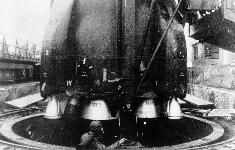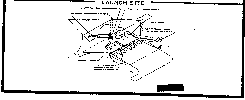





The R-16/SS-7 intercontinental ballistic missile is a two-stage, tandem, storable liquid-propellant missile capable of delivering a single 3500 lb reentry vehicle to a maximum operational range of 7000 nm,or a 4200 lb reentry vehicle to a range of 6000 nm. The SS-7 is about 100 feet long and 10 feet in diameter. The missile guidance system was inertial with a CEP estimated by the West at 1.0-1.25 nm.
The propulsion system of the first stage consists of three motors with two combustion chambers (similar to those used on the R-14 missile) and a four-chamber control engine. The pivoted combustion chambers of the control engine were placed on an external surface under fairings, which also served as aerodynamic stabilizers. The second stage had a two combustion chamber engine with that had a greater nozzle as the first stage and a four-chamber control engine. Dedicated retrorockets were used to separate the sustainer stages and the warhead. A novel and more reliable autonomous guidance control system that was protected from radio-jamming was designed for this missile.
Three versions of the R-16 missile were developed differing with regard to the number and the yield of warheads and the ensuing maximum range. Four variants of the reentry vehicle were detected by Western intelligence during the R&D program. Only the Mod 2 (ballistic coefficient equals 700 lb per sq ft; yield assesed by the West to be 2.0 to 3.5 MT) and the Mod 3 (ballistic coefficient equals 850 lb per sq ft; yield assessed by the West to be 3.0 to 5.0 MT) were deployed extensively.
The order to build an intercontinental ballistic missile designated as R-16 (8K64) was approved by the ministerial Council of the USSR on 17 December 1956. The developer was Yangel's OKB-586.
Test flights were to be started on 24 October 1960 at the Baikonur cosmodrome. However during preparation of a fueled rocket to resume a delayed launch there was an accidental engine ignition of the second stage. As a consequence of the ensuing explosion and fire about 100 people were killed, including Strategic Rocket Forces Marshal Mitrofan Nedelin. The incident was shrouded in mystery, and was first described in [not entirely correct] detail by James Oberg's books "Red Star in Orbit" and "Uncovering Soviet Disasters." Initially it was thought in the West that the disaster was associated with a failed attempt to launch a probe to Mars, and only subsequently was it understood to be a test of a new ICBM.
Flight tests resumed on 02 February 1961, and the SS-7's first successful flight test occurred on 02 April 1961. By late 1961 the first R-16 missile regiment was put on alert, though the system was not believed by Western intelligence to be operational until January 1962. The missile was fired from the surface launch complex "Desna-N", which consisted of two open launchers, a command center and a fuel depot.
In May 1960 the development of a missile designated as R-16U and its corresponding silo launch complex "Desna-V" began. The R-16U was to become the first silo launched ICBM but it also had a surface-launch capability. The launch complex consisted of three silos located in a straight line 60 meters away from each other, along with four underground command centers and fuel depots. The silo launchers had a depth of 45.6 m, a diameter of 8.3 m and a door diameter of 4.64 m.
The flight tests of the ground launched R-16U were conducted from 10 October 1961 through February 1962. The flight tests of the silo launched version began in January, 1962. The first surface-launched missile firing was conducted on 13 July1962, and this version was initially deployed on 15 June 1963. The silo launched version became operational on 15 July 1963 (simultaneously with the R-12U and R-14U missiles). The first three ground based R-16 regiments were put on alert on 01 November 1961, while the first regiment with silo based P-16U missiles was put on alert on 05 February 1963.
The system was deployed in both soft and hard sites. Between 1961 and 1965 a total of 186 mostly sufrace-based R-16 and R-16U were deployed. The SS-7 reaction time in the normal readiness condition is one to three hours for soft sites and five to fifteen minutes for hard sites. The allowable hold time in the highest alert condition (reaction time equals three to five minutes) is many hours for soft sites and days for hard sites. Maximum operational launcher inventory occurred in 1965 with some phase-out of both soft and hard sites occurring in 1971. Both missiles were phased out in 1976.
Specifications | |||||
|
Mod-1 |
Mod-2 |
Mod-3 |
|||
|
DIA |
SS-7 |
SS-7 |
SS-7 |
||
|
NATO |
Saddler |
Saddler |
Saddler |
||
|
Bilateral |
R-16 |
R-16 |
R-16 |
||
|
Service |
R-16(U) 1 |
R-16(U)1 |
R-16(U) |
||
|
OKB/Industry |
8K64(U) |
8K64(U) |
8K64(U) |
||
|
Design Bureau |
OKB-586 (Acad. M. K. Yangel) |
OKB-586 (Acad. M. K. Yangel) |
OKB-586 (Acad. M. K. Yangel) |
||
|
Approved |
12/17/1956 |
05/30/1960, |
04/27/1961 |
||
|
Years of R&D |
1956-1961 |
||||
|
Engineering and Testing |
1961-1962 |
1961-1963 |
|||
|
First Flight Test |
10/24/1960 failure 02/02/1961 success |
10/10/1961
|
07/13/1962 11/22/1963 |
||
|
IOC |
1961 |
1963 |
|||
|
Deployment Date |
11/__ /1961 |
02/05/1963, 6/15/1963 2 |
|||
|
Type of Warhead |
Single |
Single |
Single |
||
|
Warheads |
1 |
1 |
1 |
||
|
Yield (Mt) |
3, 5-6 |
3, 5-6 |
3, 5-6 |
||
|
Payload (t) |
1.475-1.5 |
2.175-2.2 |
2.175-2.2 |
||
|
Total length (m) |
32.4 � 30.44/31 |
30.44/31 |
34.3 |
||
|
Total length w/o warhead (m) |
|||||
|
Missile Diameter (m) |
3 |
3 |
3 |
||
|
Launch Weight (t) |
140.6, 141.2 |
146.6 |
148 |
||
|
Fuel Weight (t) |
130 |
130 |
130 |
||
|
Range (km) |
13,000, 10,500 -11,000 |
11,000 -13,000 |
10,500 |
||
|
CEP (m) (Russian Sources) |
2,700 |
2,700 |
2,700 |
||
|
CEP (m) (Western Sources) |
2,750-2,800 |
2,750-2,800 |
2,750-2,800 |
||
|
Basing Mode |
Soft site ground based |
Silo based |
Silo based (12) |
||
|
Number of Stages |
2 |
|
Canister length w/o front meters (m) |
N/A |
|
Canister diameter (m) |
Canister length (m) |
|
Booster guidance system |
Inertial autonomous |
|
1st stage |
2nd stage |
|
|
Length (m) |
14.5, 16.8 |
10.8 ~12.7 |
|
Body diameter (m) |
3.0 |
2.4 |
|
Fueled weight (t) |
Total 130.0 |
|
|
Dry weight (t) |
Total 10.6 |
|
|
Engine Designation |
Acad. V. P. Glushko, RD-218 (8D712) |
Acad. V. P. Glushko, RD-219 (8D713) |
|
Configuration |
Cluster of three engines + Yuzhnoy Vernier engine RD � 68 / RD-851 |
One engine + Yuzhnoy Vernier engine RD � 69 / RD-852 |
|
Design Bureau |
Acad. V. P. Glushko OKB-456 |
Acad. V. P. Glushko OKB-456 |
|
Years of R&D |
1958-1961 |
1958-1961 |
|
Propellants |
Liquid Storable |
Liquid Storable |
|
Fuel |
UDMH (heptyl) |
UDMH (heptyl) |
|
Oxidizer |
AK-27 I, ,= 73%HNO3 + 27% N204 (NTO), Nitrogen Tetroxide concentrated in Nitric Acid N02 |
AK-27 I,= 73%HNO3 + 27% N204 (NTO), Nitrogen Tetroxide concentrated in Nitric Acid N02 |
|
Burning time (sec.) |
90 |
125 |
|
Verniers Thrust Sea Level/Vacuum (Tonnes) |
28.850 / 38.7518 |
4.920 - 5.0173 |
|
Main engines Thrust Sea Level/Vacuum (Tonnes) |
225.886 / 264.8379 |
90.1 Vacuum |
|
Total Thrust Sea Level/Vacuum (Tonnes) |
254.736 -255.4/ 303.5897 Altitude |
95.02 � 95.1173 Vacuum |
|
Specific Impulse Sea Level/Vacuum (sec.) |
246-247/266 altitude 290 Vacuum |
293 Vacuum |
|
Hardness |
|
|
Launching Technique |
Soft site and silo |
|
Deployed boosters |
0 |
|
Test Boosters |
|
|
Warheads Deployed |
0 |
|
Training Launchers |
|
|
Space Booster Variant |
N/A |
Deployment Sites
|
START |
Locale US-Designation |
|
|
Bershet= |
Perm |
|
|
Drovyanaya |
Drovyanaya |
|
|
Itatka |
||
|
Kostroma |
Kostroma |
|
|
Kozel=sk |
Kozelsk |
|
|
Krasnoyarsk |
Gladkaya |
|
|
Nizhniy Tagil |
Verknnyaya Salda |
|
|
Novosibirsk |
||
|
Svobodny |
Svobodny |
|
|
Teykovo |
Teykovo |
|
|
Tyumen |
||
|
Vypolzovo |
Yedrovo |
|
|
Yasnaya |
Olovyannaya |
|
|
Yoshkar Ola |
Yoshkar Ola |
|
|
Yur=ya |
Yurya |
Historical Review - Western Estimates |
|
| Flight testing | |
| First successful attempt | April 2, 1961 |
| First Mod 2 reentry vehicle | October 11, 1962 |
| First Mod 3 reentry vehicle | November 22, 1962 |
| First Mod 4 reentry vehicle | August 30, 1963 |
| Initial operational capability | |
| Soft sites, Mod 1 reentry vehicle | January 1962 |
| Hard sites December | 1962 |
| Mod 2 reentry vehicle | 1962 |
| Mod 3 reentry vehicle | 1963 |
| Maximum operational launcher inventory | 1965 |
| Phase-out began | 1971 |



